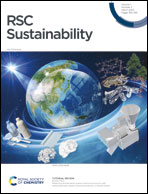The adsorption kinetics and mechanism of odorous gases onto textile fibers†
Abstract
Malodor is regarded as a very significant nuisance, 2nd only to noise pollution, in the developed world. It directly impacts people's health and wellbeing. The prevention of odor build-up is a key property for both interior textiles and active sportswear. Traditional approaches for odor elimination rely on textile surface treatment. However, the role of intrinsic morphology and chemical composition of fibers in odor elimination has not been taken into account. In this study, the adsorption characteristics and mechanisms of three common types of fibers (wool, cotton and nylon) for two typical odors of acetic acid and ammonia were systematically investigated through kinetic modelling, the inverse gas chromatography (IGC) technique, and density functional theory (DFT) calculations. Both acetic acid and ammonia adsorption onto fibers followed a pseudo-second-order kinetic model. Among all the tested fibers, wool showed the highest adsorption ability towards both acetic acid and ammonia. The adsorption behaviors of cotton and nylon were explored based on quantitative measurement of surface Lewis acid-base properties using the IGC technique. These findings were further corroborated by DFT calculations via the interactions between fibers and the adsorbed odor. This study provides a new insight into odor adsorption onto commonly used fibers and their interactions, which is a key step in developing fibrous materials for odor control, including body odor and indoor air pollutants.



 Please wait while we load your content...
Please wait while we load your content...